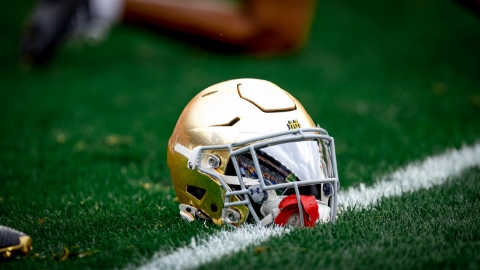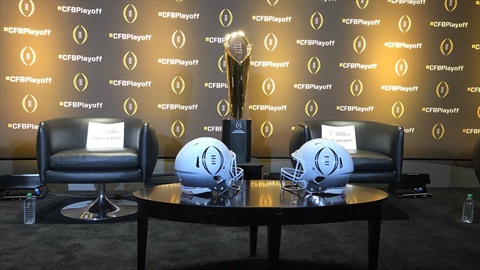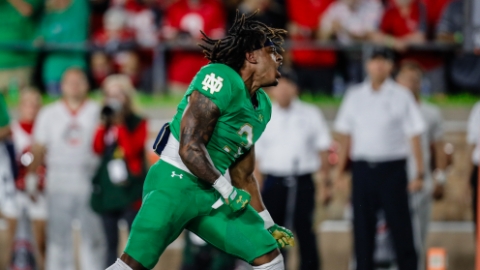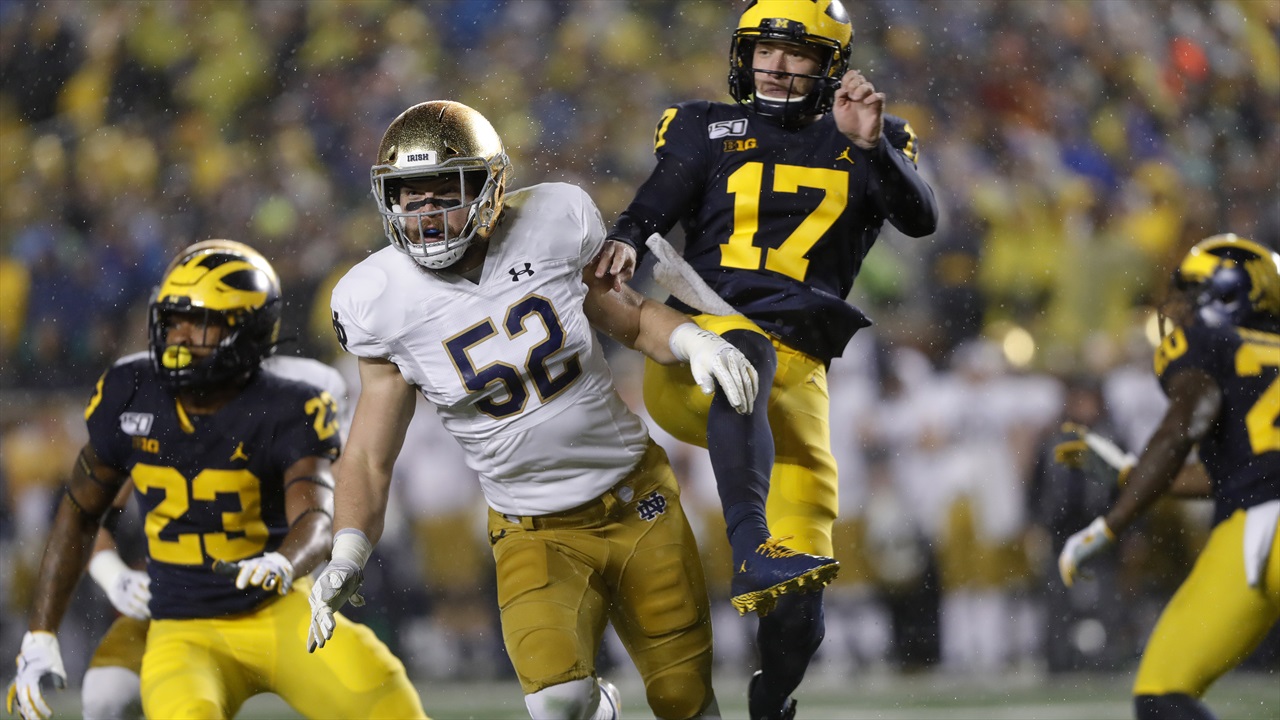
“Coach Sting” is a current coach who has spent time on both the high school and college level. He’ll be offering his expertise to Irish Sports Daily by diving into Notre Dame film and explaining what he sees.
After some great feedback on the four-part “Inside The Headset” debut looking at the Camping World Bowl Game win over Iowa State, and more specifically Tommy Rees’ debut as the Irish offensive coordinator, we are going to turn our attention to the problems Notre Dame had against Michigan last season. Plenty of you have responded and asked for a deep dive into that game and the problems the Irish faced on offense.
While I will mainly focus on the Irish offense, I feel it is important to cover what took place at the start of the game for Notre Dame. Michigan’s first series really set the tone for the rest of the game. ND tossed Michigan a couple lifelines right out the gate. Michigan took them and while only gaining three points on their first possession, the Wolverines never looked back.
1st Possession of the Game
4th & 4 on the -13
ND forced what should have been a three-and-out on the Wolverines’ first possession of the game.
On 4th & 4, Michigan lined up in a traditional pro-style punt. This includes a “gunner” split out on each side of the line of scrimmage, a long snapper with a guard and tackle on each side of him, a wing on each side, a personal protector set back to “pick up trash or insert himself into the Punt Protection” (which he does here and we will discuss), and of course, the punter.
Notre Dame lines up 8 players around the ball and rushes 7.
This leaves an “anti-chase” player on each of the gunners, acting much like a man-to-man CB and not allowing them free access to the punt returner. In the NFL, you often see two “anti-chase” players per gunner. This double-team is because the gunners are so good and oftentimes the first players to the returner. Teams also don’t want to waste punt rushers because the punt team’s operations are so efficient at that level, they get the punt off too quickly.
The Irish make multiple mistakes on this one punt return and miss out on a golden opportunity to grab the early momentum.
Because of the threat of 8 rushers, Michigan calls the personal protector into the protection.
Typically, the “PP” will make a call to tell the center to block the man to one side of him, here it is the long snapper’s left, and the “PP” takes the opposite side. This is where the count begins for who is blocking who.
For the Wolverines, all this is accounted for and they have enough to block, the problem is Michigan’s PP is on an island in space and Bo Bauer has great “get-off,” which is the key to any punt block.
It is often said by special teams coordinators that “schemes don’t block punts, players do.” Meaning unlike other special teams, offense, and defense, don’t worry too much about scheme - just go find someone who has a knack for blocking punts and you find those during punt-block drills in practice.
Coaches will study the “Block Point” for game prep and on the punt block portion of the drills, will have them align where they will be in a game and attack that block point on a direct line. So far, Bauer can check all of these boxes of proper preparation as he approaches the Michigan’s punter.
The problem lies when he arrives at the Block Point. Here, players are taught to never raise their arms about eye level, and when possible, keep them lower than that. You want to “shoot” your hands out, with one hand over the other (so there is no space for a football to go between) and take the ball off the punter’s foot.
In order for a block punt to occur, the player must have eye discipline and lock-in on the foot. Then, if he runs by the punter’s foot, he is taught to run a “J” path but have his hands trail him. This way a blocked punt can occur, but he can avoid running into the punter.
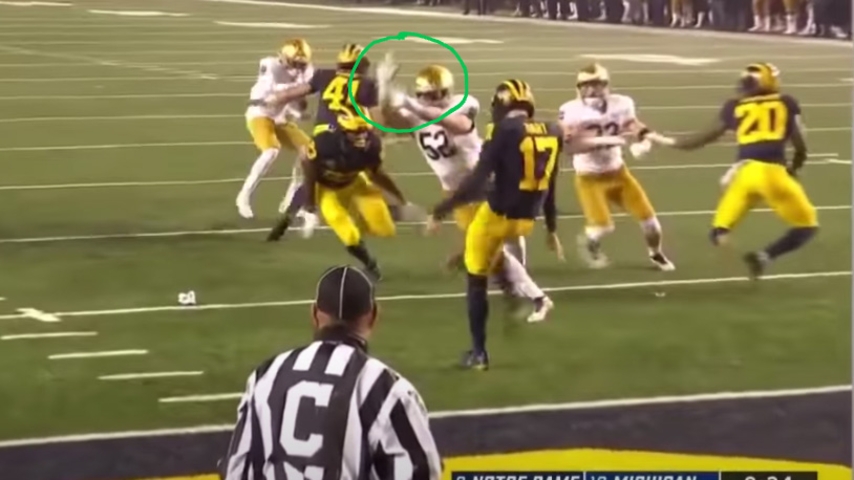
As you can see, Bauer takes a great line to the punter, however his hands are not together and they are above his eyes, and in this case, even over his helmet. He partially blocks the kick, therefore there is no penalty for running into the kicker, but this sequence sets off another poor chain of events.
The flag thrown on the Irish here is actually for holding (mistake #2 so far, at least), however the penalty is declined by Michigan because they end up with possession at the end of this play.
Here is where the next major mistake comes in and by major mistake, I mean just that - Major!
If you are already a reader of “ITH,” then you know where I stand on building fundamentals during camp. The same can be said for situational football. During a game week, there is no way to cover every possible situation that can occur during a football game, so as a coach, you work situations like when to cover kicks and when not to. From there, you sprinkle these in - possibly 2 or 3 each week, to review.
The reason this mistake is so major is because if you are part of an elite FBS program, you need to know that if you are on the punt return team and a blocked punt crosses the line of scrimmage - Stay Away!
This goes for any scrimmage kick or kicks that can be blocked; meaning conventional punts, extra points and field goals, whereas “free kicks” are kickoffs, which can also at times mean a punt (after a safety) and cannot be contested.
Players are, or should be, coached at an early age that if you are on the kick/punt block team and the ball is blocked behind the line of scrimmage - then you should try and make a play on the ball. This is because while the kicking team cannot recover the ball for a First Down behind the LOS, they can advance it for a First Down.
Conversely, if the ball crosses the LOS after being partially blocked - such as this case, then the kicking team cannot recover the ball for a first down or regain possession, unless a “muff” happens from the kicking team and that is exactly what Jonathan Jones does here on this play.
The most notorious case of this happening, for those old enough to remember this Thanksgiving Day Game, is Leon Lett.
In Jones’ defense, Lett’s is much worse because of the situation in the game, which was approximately 15 seconds left and if the Dolphins miss the FG, the Cowboys win the game. Also, the ball was spinning on the ground with his teammates yelling “poison” or “Peter,” which means to get away from the ball and they were using non-verbal hand signals to do the same.
For Jones, it was much more of a “bang-bang” play and my thought is maybe he thought the ball was already touched by a teammate. Doubtful, but possible.
Unfortunately, here is where it gets more egregious for Jones, if you jump into the rabbit hole filled with “what-if’s.” If Jones would have stayed away and Michigan tries to dive on the ball on this wet day and loses control of the ball, Notre Dame would have had the added benefit of what is referred to as “spot of first touching.”
What does all this jargon mean? Well, short-story-long, here are the worst-case scenarios for the Irish, had he left the ball alone, as he was supposed to:
1) Michigan would down the ball and ND would recover at the spot, which looks to be around the +30 yard line.
2) Michigan would touch it first, but not down it and then ND picks it up and advances it further for possibly a touchdown.
3) Michigan would touch it first, but not ‘down it’ and then ND picks up the ball, advances it, and then fumbles. In this case, ND would have the choice of the result of the play or at the spot of the “first touch” by Michigan - even if ND fumbled after the fact!
Essentially, there is no benefit for the Irish to try and attempt to down this ball first, after the blocked point, which clearly goes past the line of scrimmage.
And yes, it gets worse for Jones, who had not only a lapse in judgement, but also used poor technique. Every school, at least at the HS and college level, puts a lot of work into fumble recovery - almost daily during the football season. During these drills, each player needs to first make a decision on one of two things; “Scoop” the ball or “Fall” on it.
There is plenty of detail and technique that goes into each, believe it or not.
We already established that ND should have stayed clear of this ball after it was partially blocked and went beyond the LOS. That aside, let’s look at Jones after he made the decision to initially “Scoop” it. You guessed it...wrong again. Whenever there is traffic (Michigan players in the general area), you need to fall on the ball and cover up. We will drill into this hard idea in a moment.
PJ Fleck, the current Minnesota head coach, refers to this decision as “City or Country.” Is it a Country Play - no one around, or a City Play, lots of opponent jerseys?
Defensive players are coached constantly, offensive players usually during the spring and fall camp, that if they want to scoop the ball, they must do a few key things.
Here, Jones needed to surround the ball with his feet and have bend in the ankles, knees, and hips and be sure to “scoop” and not “pluck” it. Meaning, it is crucial to swipe blades of grass with his knuckles and bend down to scoop it with at least his pinky-fingers together and use his hands as a shovel. In the worst case, he knocks it forward and is still in position to gain possession. You cannot bend at the waist - this is the #1 reason why footballs are not scooped off the ground!
During this, Jones would be coached to yell “ME- ME”, or whatever version of that call the program has, in order to alert his teammates to protect him and block whoever is around him. I know this sounds like a lot in what happens in just a few seconds, at most. However, just like anything else - if you rep this over and over and truly perform these drills with a purpose each day, this becomes muscle memory and one does not have to think about it.
Examples I use with players all the time is I bet with them that if they actually think about when they shave or brush their teeth, I can pretty much guarantee that they start shaving with the same spot on their face each day and start brushing the same tooth every single day. Is that a conscious decision? Of course not, but it just becomes a habit after doing something over and over.
Recovering a football should not be any different.
Another somewhat obscure college football rule that not a lot of people realize is that there are no “blocks in the back” while scrambling for a loose ball. So, while Jones is fumbling around with the ball, it is legal for Michigan to push him in the back if they were close enough, in order to obtain possession. This is another reason why when there is any doubt, just cover the ball up.
As you can see here, Jones does bend at the knees, however he also does not surround the ball with his feet (each foot should be directly on each side of the ball), and bends at the waist as he tries to “pluck” the ball, rather than having his hands acting as a shovel, underneath the football.
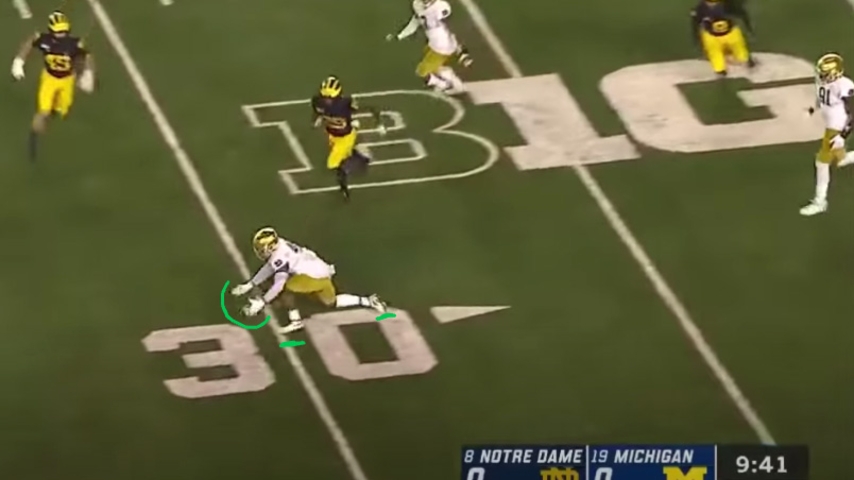
From here, Jones begins to lose possession and fumbles with the ball, so he transitions to a “cover-up” mode - the same one he should have begun with, if anything at all. This is especially true given the wet conditions. When you go to cover-up on the ground, it is important to get on the ground immediately, turn to your side, bring your chest and knees in towards the ball in a fetal position, cover it up with both arms, making sure to cover both tips of the football.
Lastly, close your eyes and mouth - yes, the pile is full of surprises! Here you can see Jones lays on top of the ball - the very thing every player is instructed not to do. As a coach, all of this wrong is even tough to type!
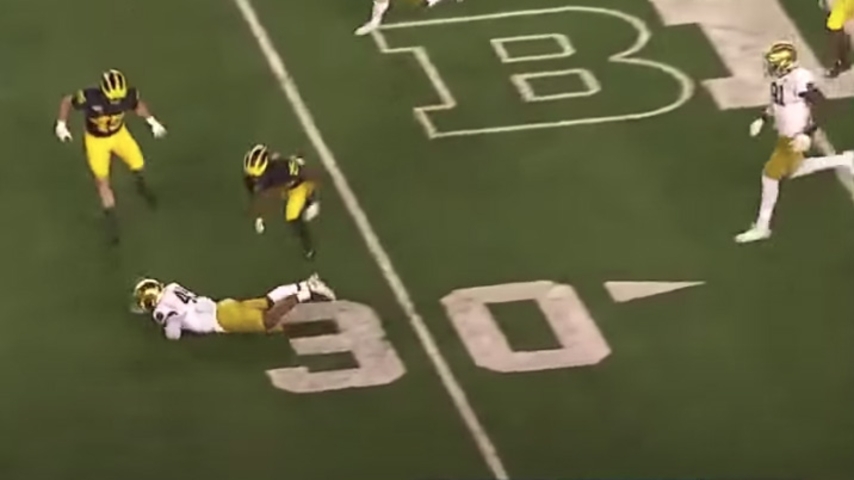
Sure enough, the ball squirts out and Michigan comes up with it giving the Wolverines their first free possession of the game.
Braden Lenzy runs up from his returner position and just looks completely clueless in traffic. He is now clearly in a “city” play and bends over at the waist and never gets on the ground with the ball.
While I mentioned offensive players don’t practice this as much, they do practice it and punt returners absolutely do or should, because they find themselves making similar type plays and decisions often.
Here is my expert analysis of Lenzy on this play: THIS IS REALLY BAD!
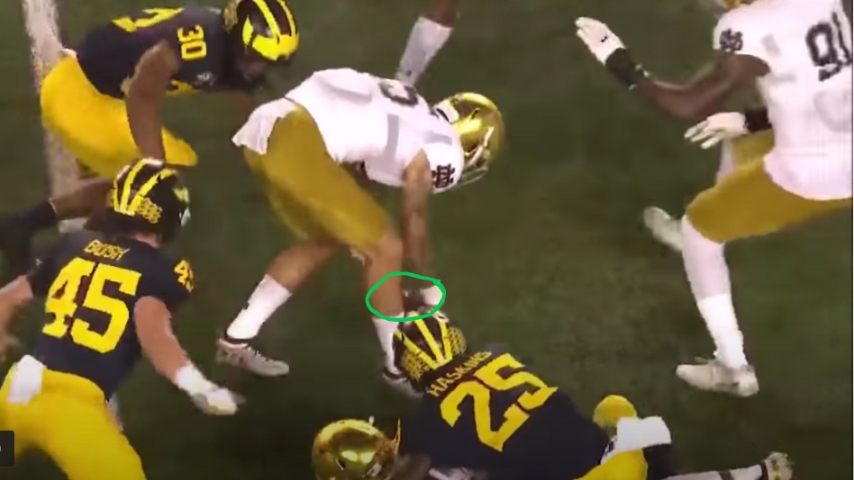
After seeing this, even if Brian Polian, the special teams coordinator, covered this situation with the punt return team - he clearly did not cover it well enough. At the end of the day, you are either coaching it or allowing it to happen.
Countless mistakes for the Irish on just one play, which became an overriding theme for the entire game, ergo the final score 49-14, in favor of the Big Blue.
Lastly for this play, it is confusing to me why Brian Kelly is arguing so vehemently with the official immediately after the play.
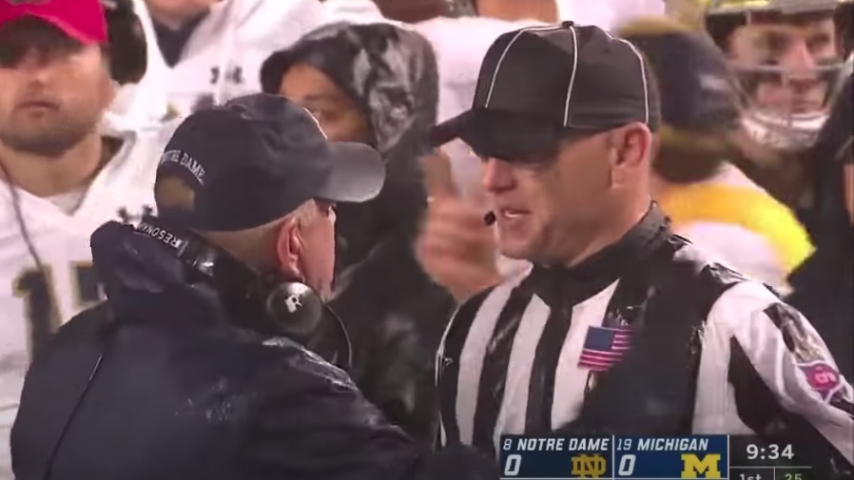
In my opinion, many of the criticisms of Kelly involving his involvement or lack thereof in recruiting, some questionable hires, personnel to scheme fit at time, and so on - all have some level of validity or can be argued, at the very least.
However, in terms of game management and his understanding of the intricacies of the game (not as common of a strength of FBS HC’s as you would think), he is at the top of his game. And yes, going at officials is one of his favorite pastimes; but on this particular play, it is simply indefensible and inarguable, in my opinion.
I would have thought he would be going straight to Jones or to Polian to figure out what in the world just took place? This one play was an embarrassment of errors, but it did not take long for things to get worse for the Irish.
1st Possession of the Game (Same Drive)
3rd & 7 on the -36
ND forces another 3rd & long and immediately Michigan is staring down the barrel again.
If there ever was the perfect call by a defensive coordinator, this is it here from Clark Lea. It has it all.
Lea knows the Wolverines love to isolate Nico Collins, who led the Big 10 in yards per catch at 19.7 yards per catch. Additionally, Lea loves to play “Man-Free” coverage, which is 5 players in man coverage underneath, 1 high safety, and rushing 5. The last part, the number of rushers, has some flexibility. There are at least 4 rushers always, and the “extra” player can either rush (most often), banjo a running back (cover the back with another LB, depending on what side the back releases to), spy the QB, or double a slot WR.
All of this is important to note, because here in the “Man-Free” look, the extra LB - Jack Lamb in this case - looks as if he is going to blitz or cover the back. Alohi Gilman is right at the LOS to show that he can either blitz or cover the back man as well - all leading Michigan to believe they are in “Man-Free.”
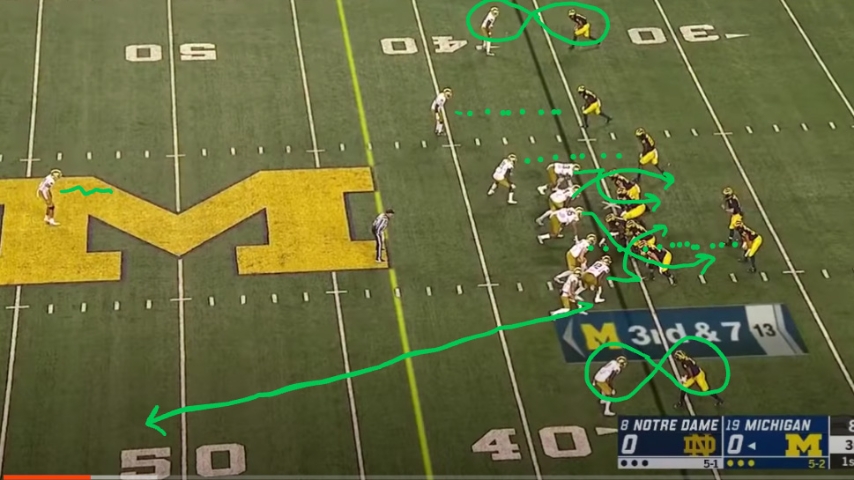
On the snap, Gilman goes on a direct line to the spot of the throw, 20 yards down the field. This puts them in a “2-Man” Coverage, which is 2 high safeties, 5 players in man coverage (in the diagram above - a “figure 8” shows press man coverage and “dotted lines” show Off Man-To-Man coverage).
Usually in 2-Man, the safeties are deep and just to the outside of the hash. This is a bastardized version for one reason only, to double cover a 6-foot-4 WR who Michigan likes to throw deep balls to (I mentioned Collins’ 19.7 ypc-average and this ball is thrown right at 20 yards, not a coincidence).
Shea Patterson takes the bait and this should work out great for the Irish - finally they can get off the field the way it should have ended the first time.
All goes to plan, except while Gilman does a great job hustling to the exact spot, he never looks back for the ball and is flagged for an obvious pass interference. The result is another free first down for the Wolverines.
Again, the result on the drive is only 3 points, but these two plays on the opening drive set a really bad tone for the remainder of the game. In addition, ND should have had the ball at the +30 yard-line set up for a possible touchdown and potential 10-point swing to start things off. We will never know.
Next time, on “Inside The Headset,” we will dive into some offensive woes in this game for Chip Long and the Irish.
You can check out all of Coach Sting’s work HERE

